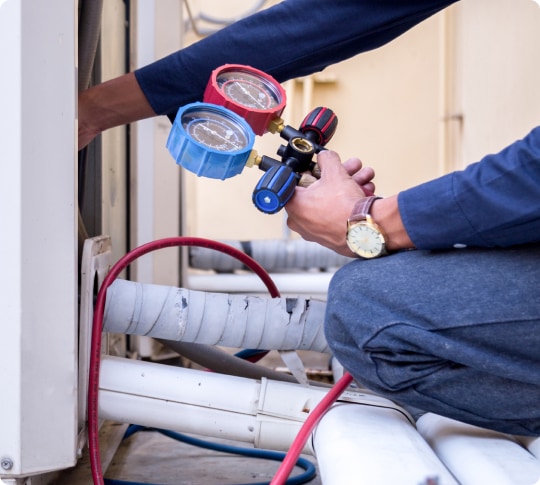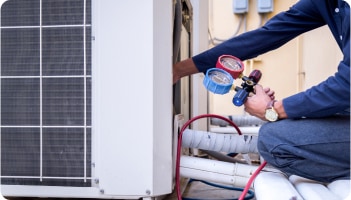Understanding How Humidity Impacts Indoor Air
Humidity is a measurement of the amount of water vapor in the air. It’s measured as a percentage and can be expressed with or without the percentage sign. For example, 50% humidity means 50 grams of water vapor for every kilogram of air. High humidity levels can cause heat-related illnesses like heat exhaustion and heat stroke. The impacts of humidity in your home include the following.
Dust Mites
Dust mites are microscopic arachnids that live in the dust of our homes. They thrive in warm environments and feed on skin cells. Dust mites are a major contributor to indoor air pollution and asthma.
High humidity levels can cause your home to have more moisture, increasing dust mites. This is because they need water to survive so that they will multiply faster with more moisture in your home. It’s important to keep humidity levels below 50% to reduce the number of dust mites in your home.
Mold
The amount of moisture in the air can significantly impact indoor air quality. Too much or too little humidity can cause mold to grow and other problems like respiratory issues. When these spores get into your home, they can grow when there is excess moisture in the air. The presence of mold spores can cause allergic reactions such as sneezing, coughing, or wheezing. It can also cause asthma attacks in people who have asthma or allergies.
Mold is a type of fungus that grows on organic matter. It’s found indoors and outdoors, but it thrives in areas with too much moisture. Mold can grow on anything that contains food or organic material—including wood, paper, carpeting, and drywall. If you see mold growing in your home or workplace, it’s important to take action.
Structural Problems
Structural problems can result from a lack of humidity in your indoor environment. The most common structural problem is a warped floor, leading to uneven footing and tripping hazards. Doors can swell in humid environments, making them hard to open and close.
Another structural problem that may occur when there is too much humidity in your home or office is wood rot when the wood absorbs too much moisture and begins to decay.
Allergens
Allergens are small particles that can trigger allergies, asthma, and other respiratory issues. They can be carried into your home on pets and people, in the air from outside, or brought in via the dust inside your home.
Allergens are more likely to settle on surfaces like carpets and drapes in dry environments. This is because they have less moisture to keep them suspended in the air. In humid climates, allergens are more likely to be spread through the air as a mist or fog.
Low humidity levels may also be problematic for asthmatics because they may cause dryness in the lungs, making it harder to breathe comfortably. This dryness can irritate your lungs and make them more susceptible to infections such as pneumonia or bronchitis (lung inflammation).
If you have been experiencing allergy symptoms recently, it may be worth investigating whether humidity levels in your home have changed.
How to Control Humidity in Your Home
Measure the Humidity
To control humidity in your home, you’ll need first to measure the moisture in your home. You can check this with a hygrometer, which will tell you the current relative humidity level in your house. Most hygrometers are easy to use, but if you’re not sure how to use yours, follow these steps:
- Turn off all fans and air conditioning/heating systems that could be contributing to the high or low humidity levels in your home.
- Place the hygrometer near a window or door where it won’t get direct sunlight for at least 24 hours before taking a reading.
- Take note of the current temperature outside to be compared against the temperature inside when taking a reading from inside your house (this will help ensure that differences between indoor and outdoor temperatures aren’t skewing results).
- Wait 24 hours before taking another reading from inside your house—this gives moisture time to settle into walls and furniture before being measured by the hygrometer (which would give inaccurate readings otherwise).
Use a Dehumidifier
Dehumidifiers are a great way to control the humidity in your home, especially if you live in an area that gets humid during the summer.
There are many different types of dehumidifiers on the market, but they all work the same way: a fan blows air over a material that absorbs water vapor from the air. The water condenses into a pan and then is removed from the machine and drained away.
Dehumidifiers can help prevent mold growth, leading to respiratory problems if it builds up in your home. The best way to keep your family healthy is to regularly clean out any mold and keep it from returning by using a dehumidifier.
You can choose between whole-home dehumidifiers and single-room units. Your professional HVAC installer can help you with a whole-home unit and it can be added to the controls of your smart thermostat. Single-room units can be purchased and placed in one room at a time, but you must remember to constantly empty the water chamber in order to keep it running.
Fix Water Leaks
If you have water leaks in your home, that can cause humidity problems. Fixing the leak will help control one source of indoor humidity. If you don’t know where the leaks are, look for damp spots on walls or floors and check under sinks and toilets for leaks. If you find a leak, turn off the water at the main valve until a professional plumber can repair it.
Install Air Conditioning Units
Air conditioners provide cooler air that holds less moisture. Because of this, air conditioning units have condensers that will remove some of the moisture from the air as it cools. This water is then drained outside through a condenser pipe in the outdoor portion of your AC or heat pump unit.
What Level of Humidity Should my Home Have?
The humidity of your indoor air is vital because it can affect your health. The recommended humidity level for indoor air is between 30 and 60%. Humidity levels that are too high or too low can cause health problems like dry skin and respiratory issues.
Contact HVAC Maintenance
The best way to reduce humidity in your home is by contacting a professional HVAC maintenance company. The professionals at Blue Bear Plumbing, Heating & Air are available 24/7 to help you remove excess moisture from your air ducts and check and clean the vents in your home. They also provide cleaning services to help you get rid of mold and mildew, which can build up over time if left unchecked.
Since 2017, Blue Bear Plumbing, Heating & Air has been the HVAC and plumbing specialist that Boston, MA, customers have relied on for exceptional results. We’re OSHA certified, BBB A+ rated, EPA certified, and bring a host of additional certifications, recognitions, and customer testimonials to back our quality of service. If you have any questions on how to get rid of humidity in your home, contact us today.
Contact Us Today



Routine maintenance is vital for the longevity of your plumbing, heating, and air conditioning systems. Sign up for our Blue Care Maintenance Plan for annual service and exclusive membership benefits, including:
- Priority scheduling
- Waived service fee during normal business hours
- 10% discount on service calls
- 3% discount on new installations
- Two-year parts and labor warranty on new equipment






